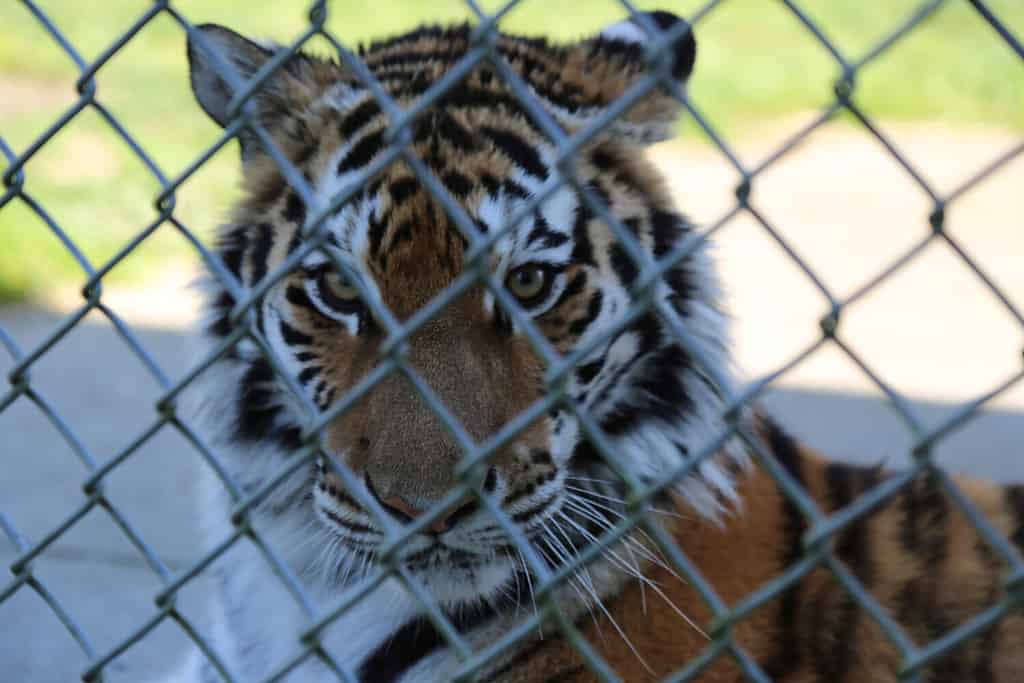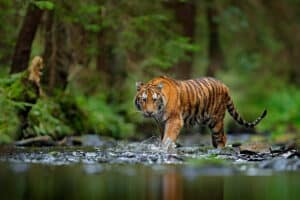Tiger ownership is a farfetched proposition for most people. Owning a tiger breaks the law in most places, and tigers themselves are not domesticated which makes them dangerous. However, this doesn’t stop those who can afford them from owning them. We’re going to go over tiger prices in 2024 including purchase cost, supplies, food, and where it’s legal to own one of these animals.
Tigers in 2024: How Much Does a Tiger Cost?

While the ethics of owning tigers is questionable, seeking
white tiger
cubs is wholly unethical.
Purchasing any kind of big cat in the United States is illegal. However, tiger sales continue in other parts of the world and on the black market.
Numerous factors affect the price of a tiger so it’s hard to generalize about the cost to purchase a big cat. How rare their specific breed is affects tiger prices the most. Their current health and age are also important when it comes to pricing an animal.
Orange tiger cubs have an average price of around 7,500 dollars. White tiger cubs fetch more than 30 thousand dollars per animal. Stripeless white tiger cubs are worth more than 100 thousand dollars.
While the ethics of owning tigers, in general, is questionable, seeking white tiger cubs is wholly unethical. White tigers are the result of a double recessive trait that is replicated in captive programs via inbreeding. As a result, almost all extant white tigers have other defects including crossed eyes and clubbed feet.

Supplies Needed When Purchasing a Tiger
A tiger’s enclosure is the most expensive part of owning a large cat. Depending on the guidelines in your area, a proper living space for your cat will cost at least 100,000 dollars. This includes a very large cage with a secure roof, and fencing for the perimeter of your property in case an escape happens. You’ll also need to have your animal on acreage as most places where tiger ownership is legal require a lot of outdoor space for your animal.
Tiger enrichment is a necessary part of a healthy life for your animal. At least a few thousand dollars per year needs to be spent on buying and replacing toys within the tiger’s enclosure.
Keeping up with the proper permits is vital to the safety of your tiger. While each state and country is different, having the correct permits in place is at least a few hundred dollars per year. If you’re caught owning a tiger without permits, your cat may be confiscated and euthanized.
How Much Does Tiger Veterinary Care Cost?
Tiger veterinary care is expensive because most veterinarians do not have the skills to care for large cats. Also, most veterinarians who care for exotic animals refuse to deal with large predators because of the dangers involved.
For a vet to properly care for your cat, you’ll need to own a squeeze cage. These squeeze cages cost up to 20 thousand dollars, and you’ll need a forklift to move them. Not having these on site is not an option, as medical emergencies come up and this equipment is vital for securing care for your tiger.
At-home healthcare for big cats includes monthly deworming, flea treatments, and vaccinations. Flea medicines run about 500 dollars per year, and deworming supplies run about 160 dollars per month. Yearly vaccines are about 250 dollars at a minimum, and that’s if you can handle vaccinating your animal at home.
How Much Does it Cost to Feed a Tiger?

Feeding a captive tiger costs between 10 thousand and 200 thousand dollars per year.
©Wirestock Creators/Shutterstock.com
Tigers eat more than 15 pounds of meat per day, with some larger cats consuming around 40 pounds a day on average. This costs about 10 thousand dollars to 200 thousand dollars per year depending on the meat variety provided and to buy the vitamins needed to keep a tiger healthy. Storing and processing this much meat requires an industrial kitchen at a minimum.
Where Is It Legal to Purchase a Tiger?

Owning tigers is illegal in the United States.
©Apsara Photo/Shutterstock.com
The legality of owning big cats in the United States changed on June 18, 2024. All big cats must be registered with the US Fish and Wildlife Service. If current big cat ownership is not declared through registration, a 20 thousand dollar fine or 5 years in prison is the consequence.
It is also no longer legal to privately own big cats in the United States, and it is illegal to conduct any kind of private big cat breeding program. Contact between the general public and any big cat at any age is also illegal. This federal law eliminates the previous privileges of cat owners in the states where big cats were once unregulated or partially regulated.
Despite these new regulations, there are still about 5,000 captive tigers in the USA. Less than 10 percent of these tigers are in accredited zoos and sanctuaries.
In Canada, it is illegal to own tigers unless you live in Ontario. Mexico allows private tiger ownership as long as the owner has the correct permits. England has prohibited tiger ownership since the 1970s.
Southeast Asian countries are under trade bans, but within the countries, laws around tiger ownership are lax. For example, in Vietnam, it is not illegal to raise tigers. However, most of the tigers in licensed facilities are bred for more nefarious purposes like the tiger bone glue industry. Glue made from tiger bones has no scientific health benefits, but many believe that it helps with conditions like osteoporosis and chronic pain management.
Why Tigers Make Terrible Pets
Remember that tigers are undomesticated predators and they make bad pets. It doesn’t matter how young a tiger was when it was spayed or neutered, it will spray urine for the rest of its life to mark its territory and as a form of communication.
Tigers are also solitary creatures that don’t remain attached to their childhood caretakers. This includes their feline mothers who they will kill in the wild as adults for their territory. At no point in a tiger’s life should the animal be trusted.
While tiger cubs are cute and easy to overpower, they become strong very fast and reach a full-grown size in about a year. An adult tiger is 12 times stronger than an adult male human which means it’s very easy for a tiger to hurt, maim, or kill their owners. Fatalities don’t just occur because of animal aggression, they commonly occur when the cat is just playing with their owner.
The photo featured at the top of this post is © Kathleen Struckle/Shutterstock.com
Thank you for reading! Have some feedback for us? Contact the AZ Animals editorial team.







